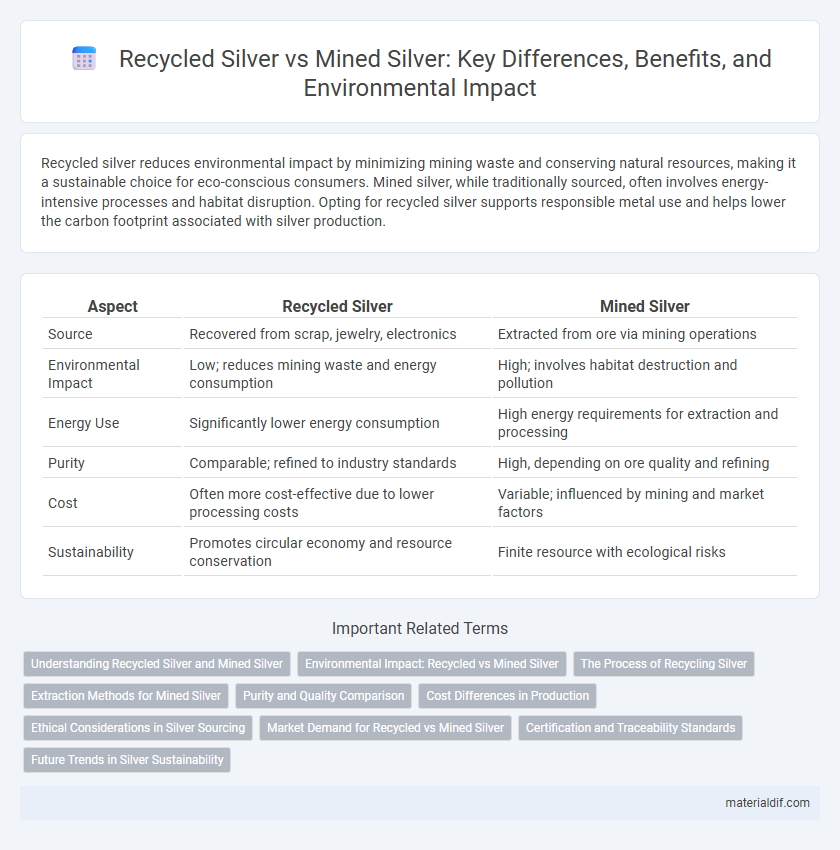Recycled silver reduces environmental impact by minimizing mining waste and conserving natural resources, making it a sustainable choice for eco-conscious consumers. Mined silver, while traditionally sourced, often involves energy-intensive processes and habitat disruption. Opting for recycled silver supports responsible metal use and helps lower the carbon footprint associated with silver production.
Table of Comparison
| Aspect | Recycled Silver | Mined Silver |
|---|---|---|
| Source | Recovered from scrap, jewelry, electronics | Extracted from ore via mining operations |
| Environmental Impact | Low; reduces mining waste and energy consumption | High; involves habitat destruction and pollution |
| Energy Use | Significantly lower energy consumption | High energy requirements for extraction and processing |
| Purity | Comparable; refined to industry standards | High, depending on ore quality and refining |
| Cost | Often more cost-effective due to lower processing costs | Variable; influenced by mining and market factors |
| Sustainability | Promotes circular economy and resource conservation | Finite resource with ecological risks |
Understanding Recycled Silver and Mined Silver
Recycled silver is sourced from repurposed silver products such as jewelry, electronics, and industrial materials, reducing environmental impact by lowering the demand for new mining operations. Mined silver, extracted through mining processes like open-pit or underground mining, involves significant energy consumption and habitat disruption, contributing to ecological degradation. Understanding these differences highlights recycled silver as a sustainable alternative with the same purity and quality as mined silver, promoting circular economy principles and reducing carbon footprints in silver production.
Environmental Impact: Recycled vs Mined Silver
Recycled silver significantly reduces environmental impact by minimizing mining waste, conserving natural resources, and lowering energy consumption compared to mined silver. Mining silver involves habitat disruption, soil erosion, and hazardous chemical use, contributing to pollution and biodiversity loss. Choosing recycled silver supports sustainability by decreasing carbon emissions and preventing toxic runoff associated with traditional mining operations.
The Process of Recycling Silver
Recycled silver undergoes a purification process where scrap silver items, such as jewelry and industrial waste, are melted down to remove impurities and reclaimed in a raw form ready for new use. This process significantly reduces the environmental impact compared to mining, as it requires less energy and water while minimizing habitat disruption. Recycling silver also conserves natural resources by extending the lifecycle of existing silver rather than extracting new ore from the earth.
Extraction Methods for Mined Silver
Mined silver is extracted primarily through underground or open-pit mining techniques involving drilling, blasting, and hauling ore to processing facilities where silver is separated using flotation, leaching, or smelting methods. This extraction process often requires significant energy consumption and generates tailings containing potentially harmful chemicals. In contrast, recycled silver is derived from repurposed silver products, reducing the environmental impact associated with raw material extraction.
Purity and Quality Comparison
Recycled silver typically retains a high purity level of 99.9%, comparable to mined silver, due to advanced refining processes that remove impurities effectively. Both recycled and mined silver pieces maintain similar quality standards, with recycled silver often used in jewelry and electronics without compromising durability or appearance. The consistent purity in recycled silver ensures it meets industry requirements, making it a sustainable yet equally valuable alternative to mined silver.
Cost Differences in Production
Recycled silver significantly reduces production costs compared to mined silver due to lower energy consumption and minimal extraction processes. Mining silver involves extensive labor, equipment, and environmental remediation expenses, driving up overall costs. The use of recycled silver lowers raw material costs and supports sustainable practices, resulting in a more economical option for manufacturers.
Ethical Considerations in Silver Sourcing
Recycled silver significantly reduces environmental impact by minimizing mining waste and preserving natural ecosystems, aligning with sustainable sourcing principles. Mining silver often involves habitat destruction, water contamination, and carbon emissions, raising ethical concerns about ecosystem degradation and community health. Choosing recycled silver supports circular economy practices, reduces reliance on conflict-prone mining regions, and promotes responsible resource management in the jewelry and manufacturing industries.
Market Demand for Recycled vs Mined Silver
Market demand for recycled silver is increasing due to rising environmental awareness and sustainable sourcing initiatives within the jewelry and electronics industries. Mined silver continues to hold significant market share because of its abundance and traditional extraction methods meeting large-scale industrial requirements. Fluctuations in silver prices and global supply chain disruptions elevate interest in recycled silver as a cost-effective and eco-friendly alternative.
Certification and Traceability Standards
Recycled silver adheres to strict certification and traceability standards such as RJC (Responsible Jewellery Council) and RM Certification, ensuring ethical sourcing and reduced environmental impact. Mined silver often undergoes rigorous auditing processes like LBMA (London Bullion Market Association) certification to verify provenance and responsible mining practices. Transparent supply chain tracking systems are integral to both, but recycled silver offers enhanced assurances through closed-loop recycling certifications.
Future Trends in Silver Sustainability
Recycled silver is projected to dominate future sustainability trends due to its lower environmental impact and reduced energy consumption compared to mined silver. Innovations in recovery technology and circular economy practices are enhancing the efficiency and purity of recycled silver, making it a preferred material for eco-conscious industries. Mined silver continues to face challenges with resource depletion and increasing regulatory pressure, driving the market toward more sustainable sourcing and refined recycling methods.
Recycled Silver vs Mined Silver Infographic

 materialdif.com
materialdif.com